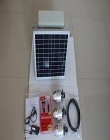 |
|
|
|
GSM / GPRS Forwarding Fault Path Indicator Solar Power Supply Remote Maintenance Station
Product Details:
Payment & Shipping Terms:
|
| Material: | White | Weight Of Repeater Station: | 6.75kg |
|---|---|---|---|
| Overall Power Consumption: | <0.4W | GPRS Module: | E-GSM/GPRS 900/1800 Dual Band |
| High Light: | power supply failure indicator,electrical line locator |
||
Abstract
The fault indicator for overhead distribution lines is used indicating of phase-to-phase and phase-to-earth faults by determining short circuit, over-current and power features to detect faults and provide a local light indication. In addition, the indicator also has current measurement and wireless data communication capabilities, by sending the fault signal to FTU,in order to comply the function of the remote communication and the remote monitoring, to help operators to find the point of failure quickly and shorten the outage time and improve reliability.
Principle
The fault indicator installed on the overhead lines, which clipped on each phase so that to detect current and Voltage signal in this phase using itself clipped line structure. Through the low-power chip, it completes current calculation, short circuit, ground fault detection, and through built-in low-power RF modules achieves short distance wireless communication.After the indicator is installed, the line current has been measured . When the current meet the characteristics of the fault, the indicator immediately sends the fault current and the fault information to the nearest terminal device by the RF, while triggering a flop and flash indication.The lineman simple follows the flashing fault indicators all the way to the first non-flashing fault indicator, thereby identify the fault location.The terminal device receives the fault information can further upload, so master station can get useful information and determine the fault zone according to the sub-station uploaded information.
Remote terminal uint is to receive the circuit fault information and circuit load operation information from overhead indicator installed in the circuit via wireless for analysis and compiling and then sends the information to main distribution network station via GPRS/GSM communications, to realize the online monitoring, fault detection and positioning functions of distribution network.
|
GSM or GPRS forwarding |
GSM (short messages) and GPRS (data) are mutually the standby mode, which are used to send the substation condition, circuit load current, indicator status and fault information to main distribution network station, to ensure the reliable transmitting of distribution network fault information. |
|
Remote upgrade |
The equipment program can be upgraded conveniently through master remote maintenance station. |
|
Work mode setting |
The terminal can be in the two-remote or one-remote working mode by setting the intrinsic parameters of remote terminal uint. |
Functions
1. Wireless receiving: the fault point information and load current information sent by indicator are received via short-range wireless network mode.
2. GSM or GPRS forwarding: GSM (short messages) and GPRS (data) are mutually the standby mode, which are used to send the substation condition, circuit load current, indicator status and fault information to main distribution network station, to ensure the reliable transmitting of distribution network fault information.
3. Solar power supply: the solar power supply mode is applied, and the maintenance-free 8AH lead-acid battery or 12AH lithium iron phosphate battery is provided, with the working temperature range of both batteries of -35℃~75 ℃ and -20℃~75℃ separately.
4. Optional communication protocol: IEC870-5-101 protocol or 104 can be selected for the connection with the third party equipment to upload the fault and shift information.
5. Remote upgrade: the equipment program can be upgraded conveniently through master remote maintenance station.
6. Convenient maintenance: the parameter setting and equipment maintenance can be performed conveniently via wireless setting terminal.
7. Event recording: the device can record the maximum 500 pieces of SOE events, providing the rich data support for system fault analysis.
![]()
Fax: 86-10-63330700
-
Overhead Line Fault Path Indicator Alarming Mode Red Flag / Flashlight
-
Alarming Mode Remote Fault Indicator , White 6.75kg Overhead Line Fault Locator For Remote Transmission Unit
-
12W / 10V Current Path Detector Remote Transmission Unit 6.75kg Weight
-
Solar Panel Fault Path Indicator Battery Replacement Remote Monitor TYHD - AI9 Model
-
Wireless Data Communication Voltage Indicator Device , Mobile Phone Ground Fault Tester
-
Short Circuit Earth Fault Path Indicator Detection System Device For Overhead Line





